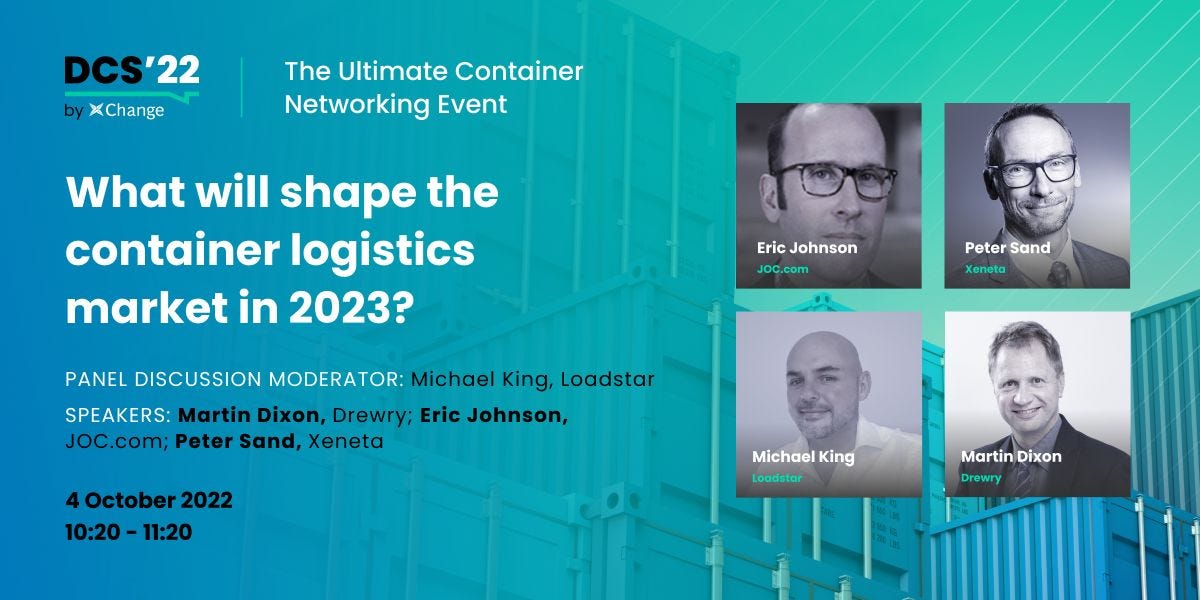LogTech's Product-Led Growth Hurdle
Welcome to the 102nd edition of The LogTech Letter. TLL is a weekly look at the impact technology is having on the world of global and domestic logistics. Last week, I argued that Flexport may have prepared forwarders for the arrival of Amazon the 3PL. This week, I’m explaining why product-led growth in logistics might just never be a thing.
As a reminder, this is the place to turn on Fridays for quick reflection on a dynamic, software category, or specific company that’s on my mind. You’ll also find a collection of links to stories, videos and podcasts from me, my colleagues at the Journal of Commerce, and other analysis I find interesting.
For those that don’t know me, I’m Eric Johnson, senior technology editor at the Journal of Commerce and JOC.com. I can be reached at eric.johnson@spglobal.com or on Twitter at @LogTechEric.
This past week I was in Chicago for the JOC Inland Distribution Conference, the first time we’ve held the event in-person since October 2019. On the last panel I moderated, Loadsmart CEO Felipe Capela was asked by someone in the audience what the current macroeconomic environment meant in terms of logistics technology moving toward product-led growth versus sales-led growth. I was jealous of the question…why couldn’t I have thought to ask that!
Capela, head of a company that has taken a good chunk of capital, but largely from corporate venture arms of companies that innately understand logistics, had a pretty clear answer. He said product-led growth just doesn’t really happen in logistics. Fascinatingly frank.
Let’s step back a sec to quickly define product-led growth and the alternative: sales-led growth. Product-led growth means the product essentially sells itself without a sales team selling it. Sales-led growth means you have a sales team actively selling the product. Capela’s answer was instructive because it aligns with my view as well. After watching a range of business models emerge the past decade, some heavily backed by venture, it’s pretty clear: you need to sell a product in logistics, you can’t just wait for people to find you. That Loadsmart essentially cuts across many of those models - tech-enabled broker, freight marketplace, SaaS provider to shippers and carriers - makes Capela’s answer all the more substantial.
But why is this so? Why does the logistics industry need to be sold to? What prevents it from coming to solutions that work? As with everything in logistics, there is no one answer. But if I had to narrow it down to three key reasons they’d be:
Lack of internal resources to study the market
Reticence to wholly rely on non-name-brand tools
Lack of interest in self-service execution
To point No. 1, most logistics teams are lean, meaning they have little bandwidth to go out and study the market on a consistent basis. This gets in the way of investment in both product- or sales-led companies, but it’s an especially big inhibitor when it comes to product-led ones. That’s because product-led tools rely on the user to find them, try them, and convert.
To point No. 2, the phrase “nobody every got fired for using IBM” is trite, but you can apply it to a range of entrenched enterprise logistics tools that are the safe bet. Most of those systems are sales-led, and that breeds a culture of the buyer “waiting to be sold to.”
To point No. 3, it’s clear that self-service is de rigeur right now, but it’s just as clear that self-service is not really what users want (and especially shippers). At least right now. They want an easy-to-use system, but they don’t want to manage it themselves, troubleshoot it, and maximize it. They want self-serve components, but not a total self-serve experience. And simply put, product-led growth is more aligned with pure self-serve tools than it is with deep and wide B2B software engagements in a complicated, multi-party industry.
Capela’s answer comes amid a time when companies can easily find themselves at a crossroads, balancing what they know their customers want with a certain growth trajectory that they know their investors seek. But there are no shortcuts in logistics. People are methodical decision-makers. Enterprises are more likely to put out RFPs - literally asking to be sold to - than they are to search Google, bust out a credit card and buy something on sight.
I think the more interesting thing to consider is whether the sales-led growth cycle can be accelerated so that it moves at a pace more akin to product-led growth.
Countdown to Discount Pricing on TPMTech
Early bird pricing for the the second annual TPMTech, Feb. 23-24 in Long Beach, Calif., expires Oct. 2 (that’s this Sunday!). Don’t miss out. We’ll be posting news on the program and keynotes in the coming weeks!
Neal Peart Lyrics of the Week:
If we burn our wings
Flying too close to the sun
If the moment of glory
Is over before it’s begun
If the dream is won —
Though everything is lost
We will pay the price,
But we will not count the cost
Here’s a roundup of recent pieces on JOC.com from my colleagues and myself (note: there is a paywall):
I wrote earlier this week about project44 unifying its products and data into a single platform, a move that signaled it knew it needed to move past disparate experiences from its acquisitions and data partners. In the same story, I also addressed rival FourKites topping off its coffers with a $10 million investment to broaden its reach in the APAC region.
Tive has been growing like crazy and two developments - a partnership with forwarder Zencargo and its tracking tool meeting stringent pharma requirements - demonstrate the breadth of utility of its tracking hardware.
The GSBN this week tested an app that lets a shipper digitally consent to allow a container line to pass shipping data onto a bank, a key step in what it believes will unlock more trade finance opportunities.
And here are some recent discussions, reports, and analysis I found interesting:
My good friend Adam Robinson recorded a cool show with industry icons Dan Gardner and Spencer Strader, who recently formed a new company called Trade Xcelerators.
Jonah McIntire is back with a bang in the first of a series on platforms as a business model for the logistics sector. You need to read this.
If you missed our Inland conference this week, reading Cathy Morrow Roberson’s detailed recaps of both days is a pretty good substitute. Here’s the Day 1 highlights and here’s Day 2.
Some upcoming events I’ll be involved in:
For early risers in the US, and morning time CET, I’ll be joining an all-star panel at Container xChange’s Digital Container Summit Oct. 4 at 4 am ET/10 am CET. Joining me to discuss where the container market is headed are The Loadstar’s Mike King, Drewry’s Martin Dixon, and Xeneta’s Peter Sand.
On the next episode of LogTech Live, 10 am on Oct. 7, I’ll be joined by Samantha Jones, VP of revenue at Rocket Shipping, to discuss her thoughts on our JOC Inland Distribution conference (where she spoke), why shippers need to be better at data, and how she raised her profile on LinkedIn. Subscribe here to get show details.
Really delighted to join Rob Garrison on his Let’s Talk Supply Chain show First Things First noon ET Oct. 11. Make sure you’re subscribed to his show here for updates and episodes.
Talking with Shippeo’s Chris Mazza during a webinar about demystifying ocean freight visibility 2 pm ET Oct. 12. Register here.
I’m moderated an hourlong JOC webcast Oct. 27 on how technology can be a differentiator for 3PLs. Register here for the free event.
Disclaimer: This newsletter is in no way affiliated with The Journal of Commerce or S&P Global, and any opinions are mine only.





I'll ask the quiet part out loud: Don't sales led companies have much lower valuations than product led companies? Isn't that a reflection of the underlying SG&A and economies of scale (unit costs)? That may be a harbinger for future logistics tech investment (and lack thereof). Physical systems like logistics could earn a reputation as the Asian Land War of technology investments.
Great analysis per usual man.
“But there are no shortcuts in logistics. People are methodical decision-makers. Enterprises are more likely to put out RFPs - literally asking to be sold to - than they are to search Google, bust out a credit card and buy something on sight. “
Nailed it.
Sometimes you need a client and the ex president of the FCBF to remind all of our investors “It is logistics after all guys..” that would readily come to my aid when I would get grilled by other investors. 😂
Super early still in the whole scheme of things (global industry wide), but regarding market-wide, buyer behavior you’re pretty spot on. In these scenarios, the best thing you can do and what we do (transparently) is point to industries where PLG is widely accepted and seemed such as in modern sales and mar tech. Salesforce, Hubspot, Atlassian...the proofs are there in many, many forms.
The GTM and how you get there is far more nuanced (and very tough to cover, will vary per startup) and what I think is generally ignored in the market.
And you can’t blame them or the buyer because they need everything now. But imo for PLG you only need those first couple of long term minded, loyal proof organizations to get the dominoes going and I think that whoever can crack this code in this industry (haven’t seen it yet, trying to) and take advantage of the rich network effects and viral loops (Ex. A Shipper “loyal” to many forwarders, and forwarders who have to hyper compete with that loyal shippers other loyal LSP’s)
All the above and for a plg startup, trying to hire locally, a true growth product manager will want closer to $200K and equity right off the bat. Tough, tough pill to swallow until you raise substantial capital..and we’re aiming to lock in our metrics first before we go anywhere near the next round of funding and actually have data backed success within the Cargologik ecosystem